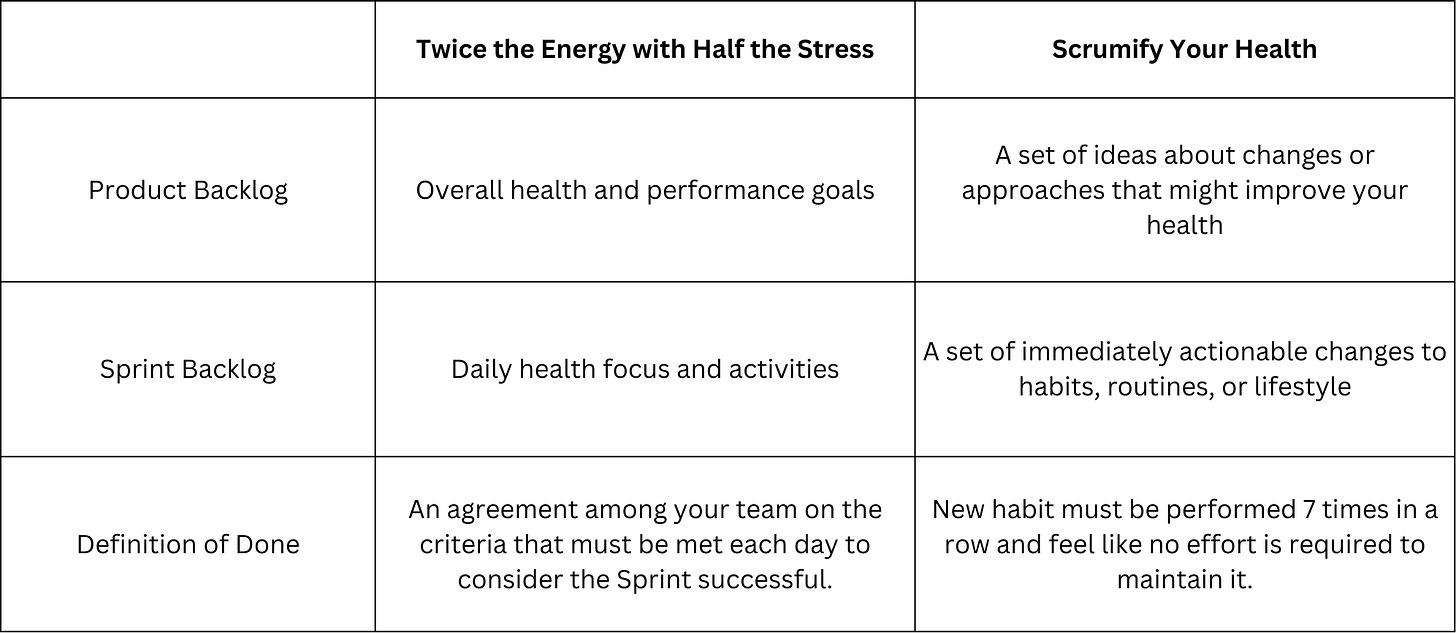In late May, a friend pointed me to a paper that had been posted on LinkedIn by Jeff Sutherland, one of the creators of Scrum. My friend knows that I’m interested in all things Scrum and Agile, especially outside of work, and the idea in Mr. Sutherland’s paper largely depends on applying Scrum to personal health.
He has created a framework called TEHS (Twice the Energy, Half the Stress) intended to improve the health of individuals, and it’s based on Scrum.
Of course I was going to read the paper. What I wouldn’t give to have twice the energy and half the stress!
Let me say briefly here that there are some issues with TEHS that make me very uncomfortable with it. I’ll write later in more detail about those issues.
But that doesn’t mean that the idea of using Scrum to improve your health is bad. And this got me thinking about how to do that.
So I took a page out of Mr. Sutherland’s paper and made my own Scrum-based framework, which I’ll call “Scrumify Your Health.”
Because of course that’s what I would call it. It’s on brand, right?
Here’s the bullet point version of both TEHS and Scrumify Your Health:
THE PRODUCT
TEHS sees your body and fitness as the product, which I respect. However, I have a hard time seeing the work you’ll do as contributing to your body in a predictably measurable way. For that reason, I prefer to think of your set of habits as the product, and health measurements of your body as outcome-based metrics.
THE TEAM
We’re in agreement on the Product Owner being the part of you that has to make decisions, but the rest of it felt too foo-foo or even downright silly for me. I think the most consequential change I’m making is that the Scrum Master is the combo of your journal and your smartwatch. This is the person on your team you want gathering metrics, checking to see how things are going constantly, and helping you discover the right changes to make.
THE EVENTS
Oh boy, do I love any opportunity to have 1 day Sprints. However, I think that if we really want to capitalize on the Sprint Review and Retrospective to inspect and make meaningful adaptations, the body is far too volatile a sandbox. You can do the same thing everyday and watch your weight swing up and down from day to day. However, over a longer period of time you should see a noticeable trend that allows you to adjust appropriately.
THE GOALS
I feel like TEHS completely abandoned these goals as they’re used in Scrum, so my version tacks a bit closer to what we’re used to. The Sprint Goal as Mr. Sutherland defined it made me literally laugh out loud, because I thought he was suggesting we should collaborate with our internal organs to decide on a goal.
THE ARTEFACTS
In this case, my Definition of Done is probably too rigid, I expect it will be amended over the course of these Sprints. As it should be, right?
THE METRICS
To Mr. Sutherland’s credit, his focus is very narrowly on increasing energy and reducing stress, so if he has a way to measure these things they’re probably a good fit. My approach is a bit more general, so I just make clear that we should be measuring outputs, outcomes, and anecdotal evidence to know if we’re building the product we should be building.
Now I’m actually using this framework to try to improve my own health over the course of the next 12 weeks, and probably longer if it proves successful. So while I’ll lay out below the framework as I’ve conceived it, please keep in mind this is very much a work in progress and it is not unlikely that it will change.
As I prepare to publish this article, I am in Sprint 3 out of a projected 12. When it’s all over, I’ll be presenting my story and my findings in a talk in the fall. So stay tuned if this is interesting to you; it’s probably all I’ll be writing about this summer.
For reference:
Original post by Jeff Sutherland on LinkedIn
Revolutionizing Wellness: The TEHS Scrum Framework for Health and Performance






